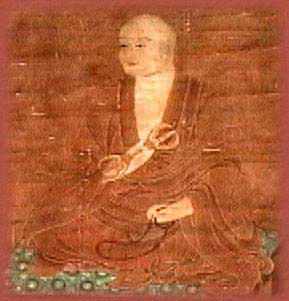Kobo Dashi (774-835)
Kukai, known posthumously as Kobo Daishi, is one of the great men of the Heian Period of Japanese history. A priest, scholar, artist and engineer, Kukai was a polymath of huge talents and the founder of the Shingon School of Japanese Buddhism.
Kukai is credited with founding hundreds of temples throughout Japan but his many achievements are clouded by the mists of time and it is debatable whether he is the inventor of the kana syllabary or the author of the iroha poem as claimed.

Early Life
Kukai was born in Sanuki province, present-day Kagawa Prefecture in Shikoku and grew up in what is now the grounds of Zentsuji Temple. From aristocratic stock, Kukai (thought to have been named Mao at birth) received an education in the Chinese classics and then went to the Daigakuryo in Nara to continue his studies of Confucianism and Taoism.
It was in Nara that Kukai became interested in Buddhism and took up a life as a wandering monk, seeking truth while practicing mantra and meditation. In 804, in spite of being outside the orbit of the official religious establishment, Kukai was selected to be part of a government-sponsored expedition, along with another famous monk Saicho (the founder of Tendai Buddhism), to China to try and understand and interpret the Mahavairocana Tantra, an early text of tantric Buddhism, first written in India.
While to us in the 21st century, this may seem like an airy-fairy enterprise with no practical application whatsoever, at that time, religion was seen as as the most powerful means of controlling one’s environment, just as science is today. Kukai’s time in China therefore equated to what today would be a scientist from an emerging nation going to an advanced nation to learn cutting edge scientific knowledge – as esoteric today as tantric Buddhism was then.
Kukai was granted permission to study at Ximing Temple in the then Chinese capital of Xian, where he was instructed in esoteric (tantric) Buddhism, Sanskrit, Chinese calligraphy and poetry. Kukai was instructed by the Chinese master Hui-Guo (Hui-Kuo), who, at the end of his life, looked to the young man to further the teaching of esoteric Buddhism (mikkyo) in Japan.
Kukai returned to Japan in 806 and is known to have been living at Jingo-ji on Mount Takao in north west Kyoto by 809.
Rising Fame
Upon his return to Japan from China, now “enlightened,” Kukai was no longer the wandering outsider. In 810 Kukai was appointed as the head of Todaiji Temple in Nara and he continued his writings and studies on what was to become Shingon Buddhism.
From 816-819 Kukai began work on raising funds for his mountain retreat at Koyasan in present-day Wakayama Prefecture, which was to evolve into a vast religious complex after his death. In the 820’s, he was also involved in repairing the huge Manno Reservoir in his home province of Sanuki, thus demonstrating his skills as an engineer.
In 823, Kukai was invited by the Emperor Saga to complete the building of Toji Temple in the south of the capital, Kyoto, and subsequently Toji became a center of esoteric practice and the new fount of his Shingon (“True Word”) sect. It was at this time that Kukai also founded Zenpukuji in Edo (Tokyo). Kukai had become a leading establishment figure.
Later Life
Kukai completed his greatest work, Jujushinron (十住心論) – Treatise on The Ten Stages of the Development of Mind in 830 – a massive tome, which was followed by a shorter summary. Thereafter, Kukai sickened and died on Mt. Koya aged 62. Kukai’s body was not cremated but entombed, according to his will, on Mt. Koya, where his followers believe, the great sage is not dead but merely meditating, awaiting the coming of the Maitreya bodhisattva, successor to the present Buddha.
Legacy
Kukai’s legacy is huge. It includes the Shikoku Pilgrimage of 88 temples associated with his life in his birthplace of Shikoku, attempted by hundreds of pilgrims (henro) each year.
The monthly temple market at Toji Temple is held on 21st day of each month, the day of his death, in honor of the great man. Hundreds of temples around Japan, celebrate him including Kawasaki Daishi in Kawasaki near Tokyo, the temple on Mt. Misen in Hiroshima is said to still have a fire lit by Kukai on his way back from China and the flame was used to lit the one at the Hiroshima Peace Park. Other temples supposedly founded by Kukai include Adashino Nenbutsu in Kyoto, Kanzenji Temple in Shizuoka and Shuzenji Temple in Izu.
Kukai’s biggest legacy, of course, is the Buddhist sect he founded – Shingon. Shingon teaches that enlightenment can be found in this lifetime through spiritual practice including mudras, mantras and mandalas. Though that enlightenment would be reached by monks practicing in monasteries, Shingon differed from Saicho’s Tendai philosophy in that it taught that enlightenment was possible in a single lifetime. Enlightenment was achieved by realizing the Dainichi Buddha – the primordial source of all beings in the universe and the underpinning of all physical forms – within one’s own body. This difference: studying tomes versus passing secretive rituals from teacher to student, is the essential difference between Tendai and Shingon.

